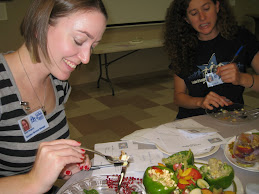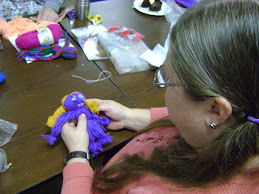Kate’s Korner – The Hidden Half
Do you think you know a lot about plants? Can you identify
all the crops in our Demonstration Garden and each flower in your pots at
home? Maybe you know how to start vegetables from seed and the kind of
compost your tomatoes like? This is all very well and important to know if
you’re a gardener, but I’m going to tell you that you only know half of
everything about plants. People learn about what they can see, but they don’t
know much about the “hidden half” of plants – their roots.
You see roots during transplanting or while tearing out a
noxious weed but you never see them in action, underground. It’s hard to
even imagine that more than half the plant is below the surface because it’s
rarely visible. Scientists have been studying plant roots for over 100
years but they still remain mysterious – there are many unanswered questions
about how they grow and move in the soil.
Roots serve four major functions – they absorb nutrients and
water, store nutrients, anchor the plant, and create plant clones. Gardeners
know to keep the soil moist and full of nutrients (fertilizer, etc) so the
roots can continuously absorb these things and stay alive. Also, if you
have ever grown crops on a slope you know how important strong roots are to
keeping these plants upright. And in terms of reproduction, most people have
seen how big a strawberry patch can get when the roots send up new starters
everywhere!
In addition to marveling at the many functions roots
perform, I am also in awe of their strength. I have often struggled over
a huge root attached to tiny, pathetic plant. Sometimes I’ve just given
up and hacked the plant off leaving the stubborn root in the ground. The
power of roots is evident in pushed up sidewalks, cracked foundations, and snapped
water lines. So consider this before you plant on oak tree up against
your house!
Roots also like to chase water. In very hot places,
they will grow very long to reach groundwater. The longest living root
ever seen was almost 200 feet long along the wall of an open-pit mine in
Arizona. Some trees and shrubs often grow roots that are 100 feet
long. Can you imagine how long it must take for water to get from the
roots up to the leaves? That’s something to think about!
Roots are also important for another reason – some of them
are edible! Why do you think it’s called a root vegetable? (Note: Some root
crops are actually buried stems). Carrots, beets, sweet potatoes, turnips,
radishes, and more! These roots are delicious and have earned an important
place in our kitchens and stomachs.
So when you start pulling up your kale or you munch into
your next carrot – think about roots and their mysterious lives deep in the
soil!
Submitted by Kate Wilkins, AmeriCorps VISTA at Sacramento Food Bank & Family Services.






No comments:
Post a Comment